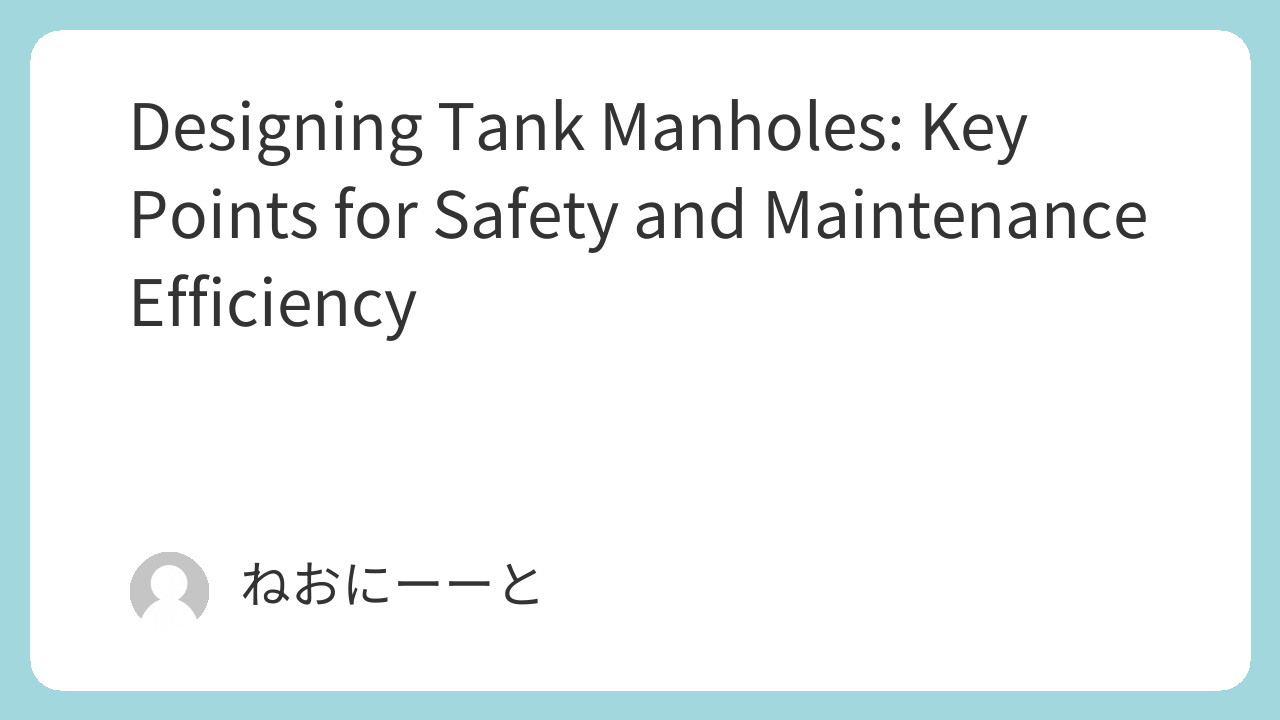Tank manholes are essential openings that allow access for inspection, cleaning, and maintenance. A well-designed manhole ensures not only worker safety but also efficient plant operations.
In this article, we will explain the basic structure, typical dimensions, material choices, and important design considerations for tank manholes. Even if you are new to chemical plant equipment, you will find this guide practical and easy to understand.
Essential Tank Terminology for Chemical Engineers|Master the Words Used in Real Plant Design
9 Common Tank Nozzle Design Patterns for Chemical Plants
Tank Nozzle Orientation: Practical Guidelines for Design and Operation
Pressure Testing in Tanks and Piping: Understanding Leak, Hydrostatic, and Water-Filling Tests
Understanding Design Pressure in Chemical Plant Tanks: A Practical Guide
The Role of Tank Manholes
- Human access: Manholes are designed for operators to enter tanks for cleaning or inspection. While larger openings are more convenient, size must be balanced with strength and weight.
- Inspection windows: Manholes can serve as visual inspection points when fitted with glass. They are often considered in the layout of tank nozzles and orientation.
- Large piping connections: In some cases, manholes double as connection points for large-diameter piping (e.g., 150A, 200A), especially in batch plants. This should be carefully designed, as it may reduce visibility inside the tank.
Typical Sizes of Tank Manholes
Common dimensions include:
- 300 × 400 mm (elliptical): Old tanks; too small by today’s standards.
- 400A (Ø400 mm): Standard size, widely used.
- 450A (Ø450 mm): Recommended for easier access, though structural checks are required.
Designers often compare these sizes with anthropometric data (e.g., average male shoulder width ≈ 45.6 cm), highlighting why 450A is often preferred for comfortable entry.
Thickness and Weight Considerations
The thickness of the manhole cover has a direct impact on safety during opening and closing.
- JIS 10k: Too heavy (400A ≈ 52.1 kg, 450A ≈ 68.4 kg). Avoid if possible.
- JIS 5k: More realistic (400A ≈ 41.7 kg). Still heavy, but manageable.
- JIS 2k: Rarely used but lighter in certain cases.
Light-opening devices, such as davits (side mount) and hinges (top mount), are recommended to reduce operator burden and improve safety.
Material Selection
- Solid stainless steel (e.g., SUS304): Durable but costly and heavy.
- SS400 with stainless steel lining: More economical, but welding and lining can introduce risks such as cracking or hidden corrosion. “Tell-tale holes” are often added to detect lining failure.
When comparing costs, the difference between lining and full stainless may be smaller than expected—sometimes only a few tens of thousands of yen compared to a tank worth millions. This highlights the importance of reconsidering traditional choices instead of following them blindly.
Key Takeaways for Design
- Ensure manhole size accommodates safe human entry.
- Minimize unnecessary weight for easier and safer handling.
- Select materials based on both cost and long-term reliability.
- Include inspection features (windows, tell-tale holes) to catch problems early.
- Consider layout impacts on piping and visibility inside the tank.
Conclusion
Designing a tank manhole is more than just choosing an opening size—it’s about balancing safety, usability, cost, and durability. By considering operator comfort, minimizing risks during maintenance, and carefully selecting materials, you can ensure reliable and safe tank operation.
Use this guide as a reference when planning or reviewing manhole designs in chemical plants or other industrial facilities.

Comments